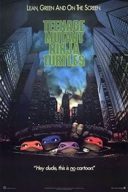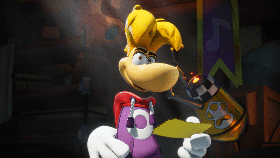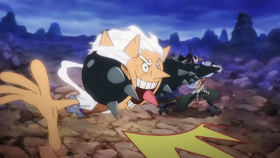The more things change, the more they stay the same. Turtle Mania has returned. The Teenage Mutant Ninja Turtles are returning to the big screen in the animated film Mutant Mayhem, which delivers a whole new take on the iconic Heroes in a Half Shell. But for many Turtles fans, nothing can quite compare to the very first live-action TMNT movie.
But how did the Turtles make the jump from indie comics sensations to darlings of the silver screen? What challenges did they meet along the way? Join IGN and TMNT co-creator Kevin Eastman for a look back at the original Teenage Mutant Ninja Turtles film.
The TMNT’s Early Years
The origins of the Teenage Mutant Ninja Turtles phenomenon can be traced back to 1984, when creators Kevin Eastman and Peter Laird first got together to spearhead Mirage Studios and self-publish the original TMNT comics. At that early stage, Hollywood wasn’t even a consideration. Eastman and Laird simply wanted to make a living writing and drawing comics. With the first issue being funded through a combination of a tax refund and a loan from Eastman’s uncle, there was no guarantee there would ever be a second.
Fortunately, the new series quickly found an audience, making it possible for Eastman and Laird to focus full-time on their new business venture. The TMNT comics grew steadily in popularity over the next several years. That was followed by the premiere of the original Teenage Mutant Ninja Turtles animated series in late 1987 and the Playmates Toys action figure line in Summer 1988. By the end of the decade, Turtle Mania was really beginning to take hold.
As Eastman explains to IGN, that’s when conversations about a Turtles movie really began to gather momentum.
“When a guy named Tom Gray approached us, he represented a company called Golden Harvest. They were best known for some really fantastic Jackie Chan movies. They brought in the incredibly... I can't say enough about how gifted and talented Steve Barron the director was. They brought in a writer named Todd Langen who wrote the script. And the icing on the cake could not have been better, Steve Barron's relationship with Jim Henson, they brought in the Henson Company to create the costumes to help bring these Turtle characters to life. And it was literally a perfect storm of things that lined up and allowed that opportunity to happen the way it did.”
To Eastman and Laird, maintaining creative control over the project was critical. Self-publishing the TMNT comic made that level of control possible, allowing Eastman and Laird to avoid the struggles faced by so many comic book creators - like their hero Jack Kirby - who signed away control of their most famous creations.
“The success of the comic and through a series of interesting sort of events, people that crossed paths, agents and people that discovered the Turtles and called, there were several that we said no to, or any further exploitation of the Turtles, we just didn't feel comfortable with them," Eastman said. "But when we met our agent and the agent through all the early years, a guy named Mark Freedman, he seemed dedicated to the commitment that Peter and I would only move forward on any Turtle project, any the other entertainment form that we had full control over."
Eastman continued, "We wanted full say in what the characters look like, what was done with them. We had approvals. And even, initially, he said, ‘That'll never happen.’ And we said, ‘Well, then, we're not interested.’ We were inspired by some creators that lost control of their characters through the companies they worked for. Years ago, that was the nature of the business, and we knew how lucky we were to own our characters. So anything that was going to be done with them we wanted full say and approval on.”
"We were inspired by some creators that lost control of their characters through the companies they worked for."
Bringing the Turtles Into Live-Action
With Golden Harvest and director Steve Barron on board, the TMNT movie started to take shape. But one thing that quickly became clear was that the movie wouldn’t simply recycle the approach of the animated series, regardless of its massive popularity. The film is much more heavily inspired by the original TMNT comics, with the plot borrowing from early issues of the series.
At the same time, some of the now-iconic elements introduced by the cartoon - the color-coded bandanas, the Turtles’ love of pizza, slang like “Cowabunga” - still made their way into the story. The film was specifically conceived as a way to draw on the best elements of both incarnations of the franchise.
“That was for all ages, kids of all ages, squarely and fairly in that. In our first meeting with [Barron], he had actually gone through and had postmarked, posted sequences from Turtles issue #1, a couple of the other issues," Eastman said. "But in particular, we did a one-shot featuring a single Turtle, Leonardo issues, elements of Issues #10 and 11. And then he had crafted a basic concept of what the movie would be based on things and scenes from those original comics. But he also loved the cartoon show to an element, and he felt that there was definitely room for a lot of humor, because the original comic books were much edgier. They were not hyper-violent or anything like that, but they were definitely intended for an older audience. And he knew that it was a kids' film made for all audiences, but the original audience would be a younger audience.”
Even though Barron envisioned an all-ages approach to the Turtles, there’s no denying that the tone of the 1990 film is much darker than the animated series. That made the project a surprisingly tough sell for most Hollywood distributors. Everyone from Disney to Universal to Warner Bros. turned down the film.
“Tom Gray tells a story from back in the day where he basically approached every studio and was told no by every studio because it was too bizarre, too out there," Eastman said. "They felt it was too far-stretched as a concept, as I guess a kid's concept would go, the tone that Steve approached it as a director.”
In the end, New Line Cinema proved to be the one studio willing to take a chance on a darker, live-action Ninja Turtles movie.
“Everybody shot it down," Eastman said. "It was Bob Shaye and the guys at New Line that saw an opportunity with it, certainly for the budget that it was at that time, which was around... I think it hovered under six... Well, they say $7 million. But I think it was a bit less. But for the budget opportunity, they had a lot of success with Nightmare on Elm Street and things like that. But they saw an opportunity to do this.”
Another hurdle facing the film was the challenge of translating the stylized, two-dimensional versions of the Turtles into three-dimensional reality. That’s where Jim Henson’s Creature Shop came in. Henson, in one of the final projects before his untimely death in 1990, oversaw a months-long effort to design latex suits with fully animatronic masks.
"To bring these characters to life in a live-action movie, if they didn't work, the movie was done before it started."
“That was a very scary time also, to put it in perspective, was that to bring these characters to life in a live-action movie, if they didn't work, the movie was done before it started," Eastman said. "And so we were very relieved and very excited that Jim Henson agreed to come on board. I think he had some concerns with the violence and the martial arts and the things. He was definitely fully Sesame Street and Fraggle Rock and the Muppet Show and all those things. So it was a risk for him.”
Eastman continued, “But when we watched the video tests and the clay sculptures, they made full-on, full-size, life-sized sculptures of the Turtles in the studio out of London. And it was surreal seeing it that way and seeing the tests, and the video tests, and the cast, the actors, and then built the suits to fit them, so that the muscles work the way they should underneath... And the first time you see all the characters, the actors dressed in the suits and interacting with each other, and it's a night shoot, and it was stop you dead in your tracks and just kind of go, "I believe this is going to work. This is fantastic." They've come to life more than we could ever have imagined.”
From Certain Disaster to Box Office Bonanza
Thanks in no small part to Henson’s team, the Teenage Mutant Ninja Turtles movie finally took shape. But that doesn’t mean everyone had faith in the project. If 1987’s Masters of the Universe movie taught us anything, it’s that a popular toy line and animated series don’t automatically translate to box office success.
Still, Eastman managed to maintain a sense of perspective as the release date neared. He and Laird had already defied the odds by turning their small, self-published venture into worldwide craze. If the movie bombed, as some feared it might, the Ninja Turtles had still had a good run.
“We'd seen early on, they were sending us video footage of dailies and things like that, and we just felt so comfortable with it on so many levels. But it was a risk to the people that had invested a lot of money in the toys, in the cartoon show, because the possibility that if it did bomb, that was kind of the end of the series, they felt.”
Eastman continued, “When we first started talking with our agent, Mark Freedman, he said, ‘Typically, the path that an intellectual property of this type potentially can follow is you'll have an introductory year. If it sells through and it's accepted by an audience, then you'll have a kind of a boom year as a second year, and then the third year, you're in the discount bins, and that's it.’ So the lifespan of what the Turtles could become beyond the comic book was all pie in the sky to us. We were fully still vested in the comic book, and that's where the dream came true. So all these other things, we were very hopeful, but we didn't know until it went out there, what it would actually do.”
In the end, the Teenage Mutant Ninja Turtles movie didn’t bomb. It proved to be one of the highest-grossing films of 1990, even becoming what was then the highest-grossing independent film of all time in the process. The film helped cement the TMNT franchise as one of the dominant forces in pop culture as the ‘90s began.
In many ways, Turtle Mania reached its zenith in 1990, but that was also the year that began to show just what legs the franchise truly had. The Heroes in a Half Shell wouldn’t flame out like so many ‘80s properties before them, but had the staying power to last through the ‘90s and into the 21st Century.
“When we started working on [Teenage Mutant Ninja Turtles II] almost immediately after the release of the first one, that was the peak, and then you sort of saw a steady, slow decline as the years went by," Eastman said. "But by 1995, '96, we were still working on cartoon shows. We were about to launch a new live-action series with Saban and Fox Kids. And the fact that it kept going, even our agent was a little bit of and kind of scratching his head in a positive way and saying, "Well..." It was surprising to him, and he said, "Maybe we're looking like the Turtles could be more of an evergreen property where it could kind of continue or have peaks and valleys." You might imagine Batman or Scooby-Doo or other properties. And to Pete and I, we were just like, ‘It is what it is. It's been really awesome, and it's been really fun. And if it continues on, how wonderful is that?’"
Eastman continued, “And the fact that it has, here we are, next year is 2024, is the 40th anniversary since the first issue came out in May of 1984, we're sitting here talking about, looking back on a movie that's 30, how many, 35 years old, at the same time looking at a new movie that's launching with a new cartoon series. And Courtney, my wife, and I still do 15-plus comic conventions and things of those type every year. And there's such a wonderful audience and fan base that that to me is, I think, probably best described as humbling, more than anything, is the fact that I still get to do what I wanted to do as a child, that childhood dream.”
But what do you think? Does the original Teenage Mutant Ninja Turtles movie stand the test of time? Can any amount of CGI spectacle top those classic latex rubber suits? Let us know what you think in the comments.
For more Turtles goodness, find out why the original TMNT arcade game was a licensed game done right and check out our full breakdown of the ending to Mutant Mayhem.
Jesse is a mild-mannered staff writer for IGN. Allow him to lend a machete to your intellectual thicket by following @jschedeen on Twitter.





